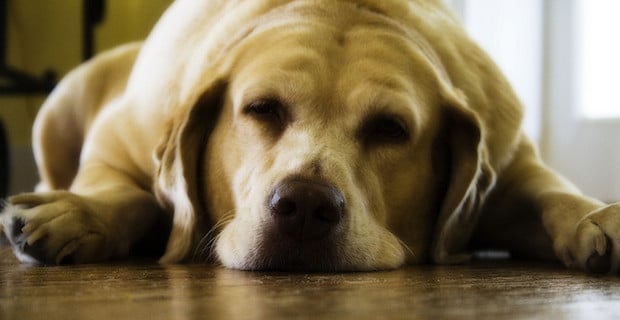
I always cringe whenever I see a fat dog. Dogs who are overweight or obese typically struggle to go up steps, rise from a reclining position, or even walk. Overweight male dogs can have difficulty lifting their leg to urinate. It’s a sad, uncomfortable, and most unhealthy way to live.
As a responsible pet parent, you can take steps for your overweight dog that can result in significant improvements in his or her health and lifestyle and thus make your years together more joyful and meaningful as well. First, however, you need to recognize and acknowledge that your dog may be carrying too much baggage.
“My Dog Isn’t Fat…Is He?”
Such an acknowledgement turns out to be difficult for many people. Let me explain. According to the 2012 National Pet Obesity Awareness Day Survey, which was conducted by the Association for Pet Obesity Prevention (APOP), 52.5 percent of dogs (about 36.7 million) are overweight or obese in the United States. However, nearly half (45.8%) of dog parents said their dogs were of “normal weight” even though a veterinarian identified them as being overweight or obese.
This inability to correctly identify one’s dog as being too fat is what Dr. Ernie Ward, the founder of APOP and the study’s lead investigator, calls “the fat gap.” He noted that “many pet owners are shocked when their veterinarian informs them their pet needs to lose weight. They just don’t see it.”
What Pet Parents Can Do
First of all, conduct a quick objective examination of your dog. You should be able to feel his ribs along the side of his chest when you run your fingers down his side and press gently. Then stand and look down at your dog’s back; you should see a slight hourglass shape immediately below the ribs. If you can’t feel the ribs and/or your dog’s waist is rounded or bulging, it’s time to drop a few pounds!
Read more about how to introduce your dog to raw food
It’s recommended you get confirmation of your dog’s weight issues from your veterinarian and then decide on a diet course of action. This will likely include a change in dog food, either in the amount you feed, the brand, and/or type of food (dry vs wet vs homemade).
Do your own research on how to best feed your dog (see the APOP website for tips). It is not necessary to purchase high-cost diet food for your dog, but you do want to be sure to provide nutritionally balanced fare that helps your dog lose weight. Be sure to discuss possible challenges in changing your dog’s diet, such as providing low-calorie treats to keep him satisfied (e.g., carrots, string beans) or providing chew toys to distract him.
Read more about pet-friendly fruits for your dog
And speaking of action, exercise is critical when helping your dog lose weight and to prevent health problems. Dogs, unlike cats, are easier to exercise. However, it does take a commitment from you or others whom you engage to ensure your dog gets lots of physical activity on a daily basis. Whether that means your partner, spouse, children, friends, relatives, or a neighborhood teen who needs some extra cash, be sure your dog exercises.
Consult with your vet before starting an exercise program, especially if your dog has any health problems, so a safe and effective plan can be put into action.
Health Problems in Fat Dogs
Fat dogs can’t join a gym or a weight-loss club; they are forced to live with the potential or the reality of significant health issues associated with their excess pounds unless their pet parents take action. The fat-related health problems they face are sometimes associated with their breed and/or size. For example, dachshunds have short legs and long backs and are prone to slipped disc disease. Therefore, overweight dachshunds are at high risk of developing this debilitating condition.
Larger dogs, such as golden retrievers, Labradors, German shepherds, and especially Great Danes who are allowed to become overweight can suffer extensively from serious joint damage that can result in arthritis. In fact, about 25 percent of fat dogs develop life-altering joint complications. Excess weight also can damage ligaments, particularly those in the knees. If these ligaments tear, dogs often need surgery to repair the damage.
Read more about treating your pet's arthritis
Excessively heavy dogs are also at significant risk of other health problems. Hypertension (high blood pressure), for example, for example, can develop and ultimately lead to congestive heart failure. Breathing difficulties are common among overweight dogs, especially short-faced breeds, such as Boston Terriers, boxers, pugs, Shih tzus, and Lhasa Apsos.
Your overweight dog may also experience heat intolerance in the summer, reduced liver function, hypothyroidism, and even some types of cancer (e.g., mammary cancer, bladder cancer). Clearly, being a fat dog has some very uncute consequences.
Unlike cats, in whom diabetes and overweight/obesity are intimately related, diabetes in dogs is mostly believed to be hereditary or due to genetics. However, obese dogs and especially heavy female dogs seem to have a greater risk of developing diabetes in their later years.
Chubby puppies are adorable, but like chubby infants and toddlers, they can grow up to be overweight or obese adults and experience a host of health problems. Responsible pet parents can help their fat dogs lose weight and gain a better quality of life. APOP offers weight loss tools and information to help pet parents.
Photo Credit: butler.corey










